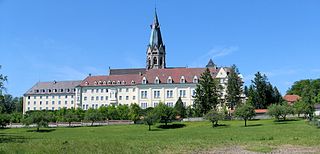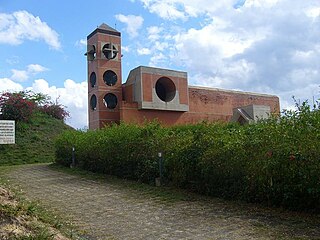St. Andrew's Abbey is a male Benedictine monastery of the Congregation of the Annunciation located in Valyermo, in the Mojave Desert, northern Los Angeles County, southern California.

The Beuronese Congregation, or Beuron Congregation, is a union of mostly German or German-speaking monasteries of both monks and nuns within the Benedictine Confederation. The congregation stands under the patronage of Martin of Tours, who is the patron saint of the Archabbey of Beuron.

Maredsous Abbey is a Benedictine monastery at Maredsous, in the municipality of Anhée, Wallonia, Belgium. It is a founding member of the Annunciation Congregation of the Benedictine Confederation.

Gerard van Caloen (1853–1932) was a Belgian Benedictine liturgist, missionary, monastic founder, abbot, and bishop. He was rector of the abbey school at Maredsous, where in 1882 he published the Missel des Fidèles, the first French-Latin missal. He also introduced British-style association football to the school. In 1886, he was professor of liturgy at the College of Sant'Anselmo in Rome.

St. Ottilien Archabbey is a Benedictine monastery in Emming near Eresing and the Ammersee in the district of Landsberg, Oberbayern, Germany. It is the motherhouse of the St. Ottilien Congregation.

The Ottilien Congregation, often also known as the St. Ottilien Congregation and as the Missionary Benedictines, is a congregation of religious houses within the Benedictine Confederation, the aim of which is to combine the Benedictine way of life with activity in the mission field.

San José Abbey, Güigüe, Venezuela, is a Benedictine abbey of the Congregation of Missionary Benedictines of Saint Ottilien. Currently located to the south of Lago de Valencia, the monastic community was originally established as a mission procure in Caracas following World War I. Caracas' expansion restrained the development of the abbey, and in the late 1980s the monks relocated to Güigüe. The community's superior is Fr Abbot José María Martínez Barrera.
St. Andrew's Abbey, Bruges was a Benedictine abbey in Sint-Andries, Bruges, Belgium, which was destroyed in the French Revolution. Its modern successor St. Andrew's Abbey, Zevenkerken, founded in 1899–1900, is a Benedictine abbey of the Congregation of the Annunciation.

Thomas Spreiter, OSB was a German missionary, one of the first of the Missionary Benedictines, who worked in German East Africa and later South Africa. He was the ordinary of the Roman Catholic Archdiocese of Dar-es-Salaam in German East Africa, and bishop of the Apostolic Vicariate of Natal and of the Vicariate of Eshowe.
Inkamana Abbey, also called Sacred Heart Abbey, Inkamana, is a Benedictine abbey in Vryheid, KwaZulu-Natal, South Africa, in the Roman Catholic Diocese of Eshowe. It belongs to the Ottilien Congregation.

Tokwon Abbey was a Benedictine monastery of the Congregation of Missionary Benedictines of Saint Ottilien, located near the town of Wonsan in what is now North Korea. Founded as a monastic mission in Seoul, the community transferred to Tokwon in the 1920s to take charge of the newly created Apostolic Vicariate of Wonsan. The persecution of Christians in North Korea since 1949 made any church activity in the abbacy impossible. However the Territorial Abbacy of Tokwon is formally still kept as one of the few remaining territorial abbeys within the Catholic Church.

Maurus Wolter was the first abbot of the Benedictine Beuron Archabbey, which he founded with his brother Placidus in 1863.
The Abbey of Our Lady Help of Christians, Ndanda, Tanzania, is a Benedictine monastery of the Congregation of the Missionary Benedictines of Saint Ottilien. Established in 1906 as a mission station in German East Africa, the monastery is currently home to 71 monks. On 25 March 2021 the community elected Fr. Christian Temu OSB its 6th abbot.
St Paul's Abbey, Newton, New Jersey, is a Benedictine simple priory of the Congregation of Missionary Benedictines of Saint Ottilien. Originally established as a mission procure following World War I, over time the size of the community drastically decreased. In 2002, monks from Waegwan Abbey, South Korea, took charge of the monastery. On January 25, 2004, Newton II was elevated to the status of a simple priory. The community's superior is Fr Prior Samuel Kim.
St Otmar's Abbey, Uznach, Switzerland, is a monastery of the Congregation of Missionary Benedictines of Saint Ottilien. It was established in the wake of World War I to expand the Congregation's resources beyond Germany. To this day, the monastery continues to procure funds and send personnel to Benedictine missions in the Global South. The current superior of the monastic community is Fr Adelrich Staub, Prior Administrator.
The Abbey of St. Maurus is a Tanzanian Benedictine monastery of the Congregation of Missionary Benedictines of Saint Ottilien in Hanga, Ruvuma Region. Established in 1956 by Abbot-Bishop Eberhard Spiess as a formation house for African monastic candidates, the monastery is currently home to 122 monks. The abbey operates schools and a dispensary for the people of the local village and a seminary for the Roman Catholic Archdiocese of Songea.

Saint Maurus and Saint Placidus Abbey, Waegwan, Chilgok, North Gyeongsang, South Korea is a Benedictine monastery of the Congregation of Missionary Benedictines of Saint Ottilien. Established in 1952 by Korean monks who had survived the dissolution of the Territorial Abbey of Tokwon and Holy Cross Abbey in Yanji, the monastery is currently home to 131 monks. Fr Blasio Park is the current abbot.
Holy Cross Abbey, Yenki (Yanji), Jilin, China, was a Benedictine monastery of the Congregation of Missionary Benedictines of Saint Ottilien. Established in 1922 as a mission station, the monastery later became the seat of the Vicariate Apostolic of Yenki. After the withdrawal of Soviet forces following World War II, the monastery was suppressed by the People's Republic of China. While many of the monks were repatriated to Europe, others moved to South Korea and founded the Abbey of Waegwan.

The Congregation of the Annunciation, formerly known as the Belgian Congregation, is a congregation of monasteries within the Roman Catholic Benedictine Confederation. Founded in 1920, the Congregation includes fifteen independent male monasteries spread throughout ten countries. Additionally, two female monasteries are members of the Congregation, while a further ten are affiliated with the Congregation.
The Brazilian Congregation is a monastic congregation of the order of Saint Benedict. Founded in 1827, it is a member of the Benedictine Confederation.










